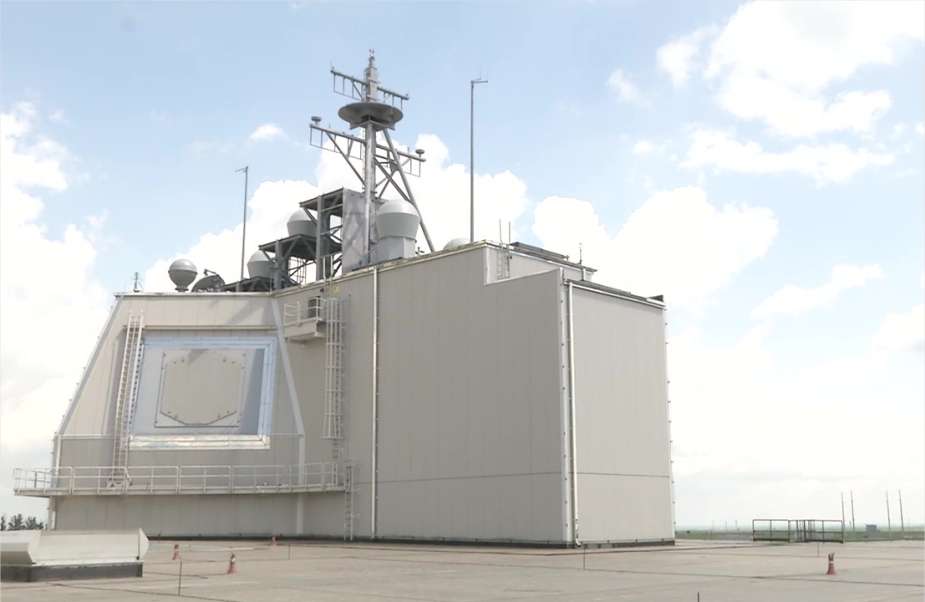On December 15, 2023, the US Navy officially took over the Aegis Ashore Missile Defense System (AAMDS) from the US Missile Defense Agency. Located at the Naval Support Facility Redzikowo in Poland. This land-based adaptation of the Aegis Ballistic Missile Defense (BMD) System is specifically designed for defense, enhancing NATO's capabilities against ballistic missile threats.
Follow Navy Recognition on Google News at this link
 The Aegis Ashore system, similar to its counterpart in Romania, is designed with a defensive purpose, aiming to expand defensive coverage for NATO's European countries. (Picture source: US DoD)
The Aegis Ashore system, similar to its counterpart in Romania, is designed with a defensive purpose, aiming to expand defensive coverage for NATO's European countries. (Picture source: US DoD)
The AAMDS in Redzikowo, Poland, is scheduled to become fully operational and under NATO command between spring and summer of 2024. It underwent a maintenance and upgrade period starting on December 15, 2023. These upgrades focused on enhancing the system's network and computer systems. The Polish Aegis Ashore system, similar to its counterpart in Deveselu, Romania, is designed with a defensive purpose, aiming to intercept ballistic missile threats, particularly those originating from regions such as Iran. Its primary role is to expand defensive coverage for NATO's European countries.
The Aegis Ashore is a land-based adaptation of the Aegis Ballistic Missile Defense (BMD) System, initially developed for deployment on warships. The system employs Standard Missile 3 (SM-3) mid-course interceptors, as well as Standard Missile 2 (SM-2) and Standard Missile 6 (SM-6) for terminal-phase interception, to counter short to intermediate-range ballistic missiles.
Historically, the Aegis BMD system traces its origins to the Strategic Defense Initiative of the mid-1980s. Over the years, the system has evolved, incorporating technological advancements and integrating off-board sensors to improve targeting accuracy. As of 2022, the Aegis BMD system includes upgraded versions with enhanced processors, software, and SM-3 interceptor missiles.
Furthermore, the US Army's Integrated Air and Missile Defense Battle Command System (IBCS) program aims to integrate various land, sea, and air-based sensors and radars, including the Aegis radar system, to establish a networked defense system. This integration is intended to enhance the anti-ballistic missile capabilities of surface-to-air missile launchers.
The Aegis Ballistic Missile Defense (BMD) system, which forms the foundation of the Aegis Ashore Missile Defense System (AAMDS), uses the RIM-161 Standard Missile 3 (SM-3) for mid-course interceptions and the RIM-156 Standard Extended Range Block IV (SM-2ER Block IV) for terminal-phase interceptions, both developed by Raytheon.
The SM-3, an advancement of the SM2-ER Block IV, is engineered to intercept ballistic missiles above the atmosphere (exo-atmospheric intercept) during their midcourse flight phase. Launched from the Mk 41 Vertical Launching System (VLS) on warships, the SM-3 receives in-flight updates from the ship. Its kinetic warhead is designed to destroy a ballistic missile's warhead with an impact force exceeding 130 megajoules of kinetic energy. The current SM-3 Block IA version is set for upgrades to the Block IB, Block IIA, and Block IIB versions to enhance its capabilities against evolving ballistic missile threats.
In March 2018, the Missile Defense Agency (MDA) assessed the SM-3 Block IIA missile's capability against Intercontinental Ballistic Missile (ICBM) class targets. If proven effective against ICBMs, the SM-3 Block IIA could augment the existing Ground-Based Midcourse Defense (GMD) system. On November 17, 2020, the SM-3 Block IIA missile successfully intercepted an ICBM-representative target during its mid-course phase of flight, demonstrating its ability to engage various types of ballistic missile threats.
The RIM-156 Standard Extended Range Block IV (SM-2ER Block IV), used for terminal-phase interceptions, is capable of engaging ballistic missiles within the atmosphere (endoatmospheric intercept) during their terminal phase. This missile is equipped with a blast fragmentation warhead. Its further development led to the RIM-174 Standard ERAM (Standard Missile 6 or SM-6), which includes an active radar homing seeker. The SM-6 is a dual-purpose missile, suitable for air defense—targeting aircraft and anti-ship cruise missiles—as well as for terminal ballistic missile defense. It is designed to work alongside the SM-2 series, providing extended range and additional firepower capabilities. In January 2018, the Navy initiated the development of a Dual Thrust Rocket Motor for the SM-6, featuring a larger 21-inch diameter compared to the existing 13.5-inch propulsion system. This development paved the way for the creation of the SM-6 Block IB variant.



